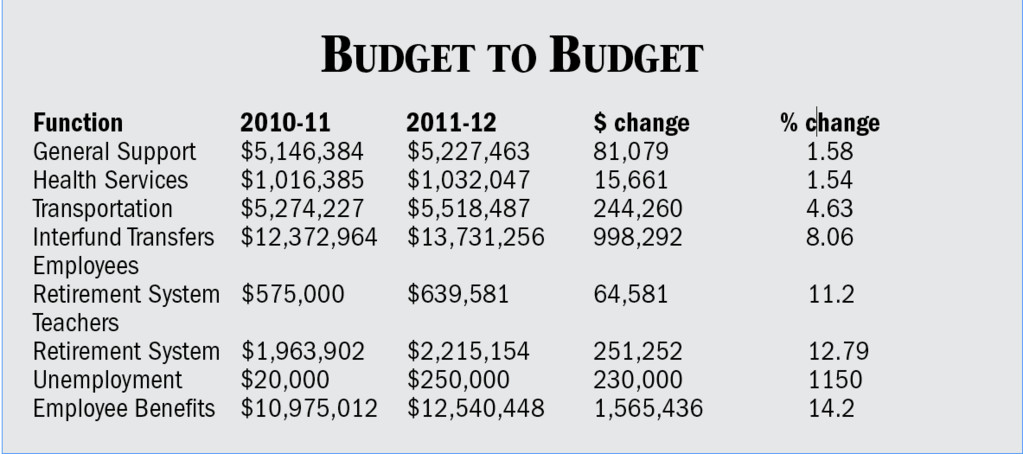District faces $2.4 million budget gap
Throughout the last two budget seasons, the West Hempstead school district has excessed nearly 85 positions, including administrators, teachers, clerical staff and coaches. It altered its academic intervention services and the ways in which it delivers special education services. The district has seen an increase in class sizes and the elimination of some clubs and sports teams. Somehow, it is still left with a $2.4 million budget gap for the 2011-12 school year.
That “somehow” is the result of state aid cuts, the loss of federal stimulus funds, new county taxes and skyrocketing increases in state-mandated retirement costs, among other things.
“We find ourselves in an extremely challenging budget cycle, which began with the collapse of the economy in September 2008,” district Superintendent John Hogan said at the Board of Education’s first budget workshop of the year on March 1. “And while Wall Street may have recovered, the reality is that Main Street has yet to do so, and certainly New York state, the local municipalities and school districts continue to struggle to make ends meet and still serve their communities. West Hempstead is no different.”
West Hempstead’s chief administrators presented the first piece of the district’s proposed budget to board trustees in the West Hempstead Middle School cafeteria last week. Dozens of community residents turned out for the workshop, which focused on non-instructional items, including salaries, facilities-related expenses and staff, insurance, transportation and benefits.
In his opening statement, Hogan told the board that the district is facing anywhere from $270,000 to $400,000 in additional expenses. Many of those expenses are largely out of the district’s control, the superintendent had said, particularly pension, health and energy costs. Nassau County’s new sewer tax could add as much as $90,000 to the district’s water bill, Hogan said. The costs of tax certiorari judgements, which county Executive Ed Mangano plans to place on school districts starting in 2013, could cost the district up to $300,000 down the line. The district will have to shell out an additional $80,000 if Gov. Andrew Cuomo’s proposal to move summer special education costs out of the state budget and into school district budgets.
“In order to balance the proposed budget, there is no question that sacrifices and cuts will have to be made,” Hogan said. He expects to cut some 15 to 20 administrative, teaching and support staff positions. In anticipation of that, the administration budgeted more than 10 times the amount of the current year’s unemployment insurance for that of next year.
The district will undergo a number of programmatic cuts as well, Hogan said. He’s already considering the elimination of summer school support. West Hempstead has already lost a number of individual honor societies, its wrestling program and its seventh-grade boys’ and girls’ basketball and volleyball teams. District-wide intramural sports are no longer supported in West Hempstead’s budget.
While increases in general support and health services expenses were relatively modest, costs related to transportation grew by nearly 5 percent. The district plans to follow through with improvements it planned last year for the George Washington elementary school and for the middle and high schools, as well as to purchase new buildings and grounds equipment through a five-year lease purchase plan.
The administration’s goal, according to Hogan, is to balance all the needs, wants and musts in order to provide the most comprehensive experience for its students and best work environment for it employees.
“I believe that together, we can meet out economic challenges and still meet the educational needs of our students,” Hogan said. “There is little question that education in West Hempstead will look different as we move into the future, but I submit to you that it is going to look different everywhere — all you have to do is look at the news each day to see that all districts find themselves in the same boat. Education will be different, but still effective. As far as I am concerned, less money does not mean less quality. Our school district is going to continue to strive for excellence in all we do.”
The task before the administration, the board and the entire school community is significant, Hogan added. “But we face it together,” he said. “None of us can afford the luxury of approaching this budget season through only the lens of our own interests. We must widen our lens to see the whole picture.”
Despite the obstacles and tough decisions facing the district, as well as the memory of the first budget proposed for 2010-11 that taxpayers voted down, Hogan remains optimistic.
“[B]y walking in each others’ shoes, by listening to one another and realizes that sacrifices will be required across the board, we can approach our challenge with a positive attitude and with confidence,” he said, “in the knowledge that together we can and will succeed in this budget season.”






